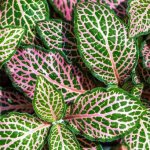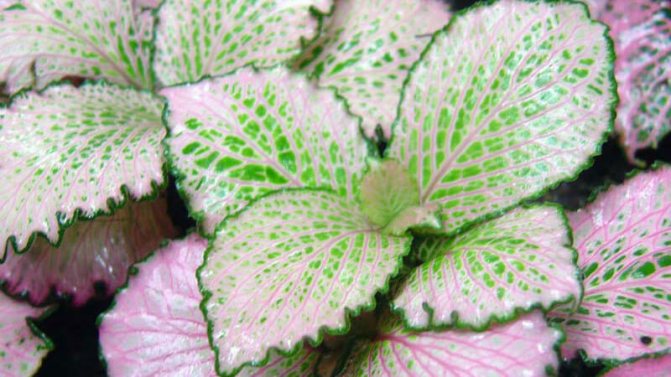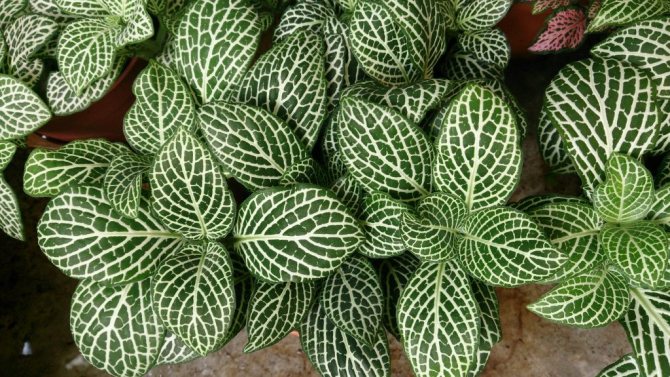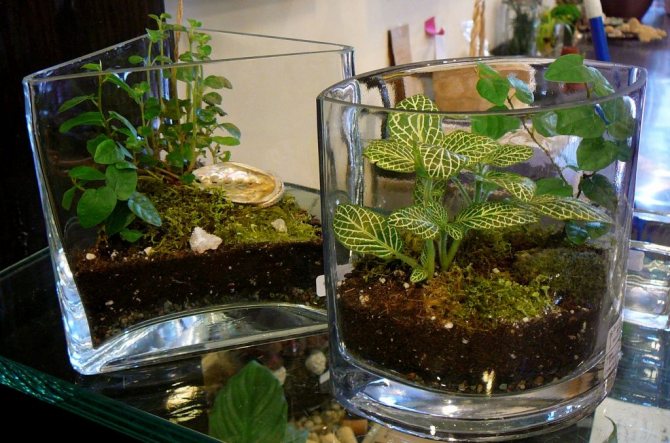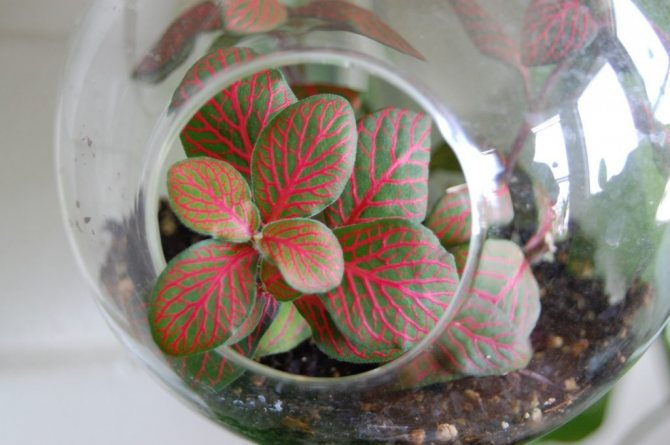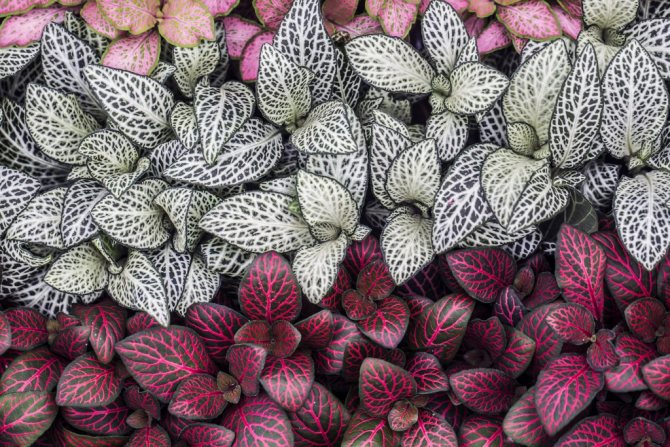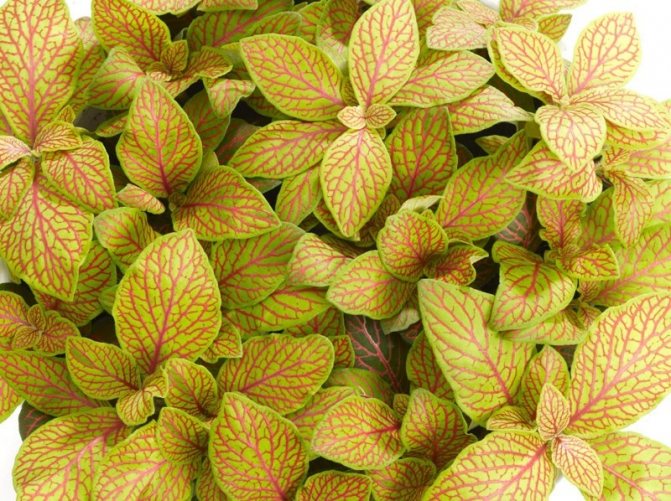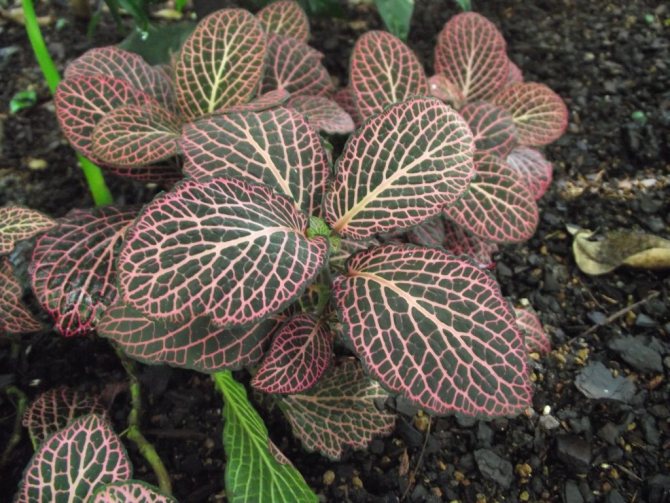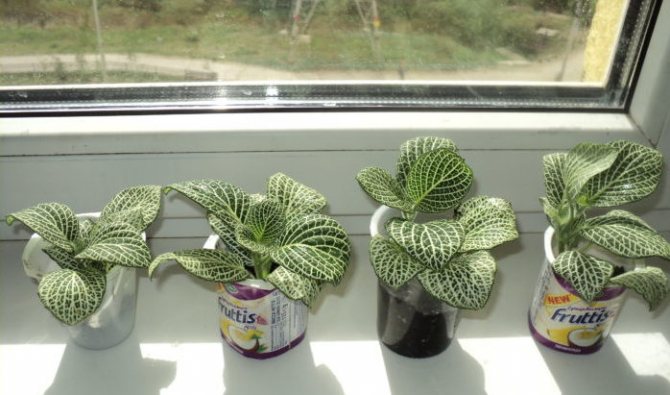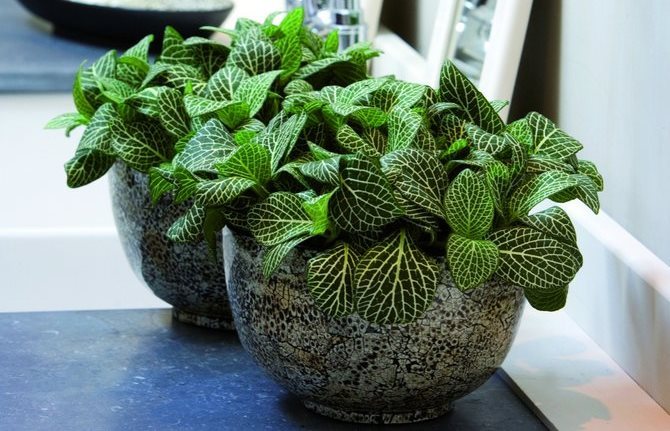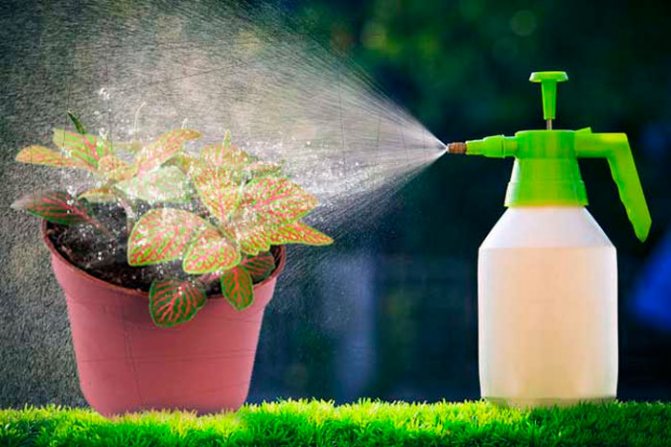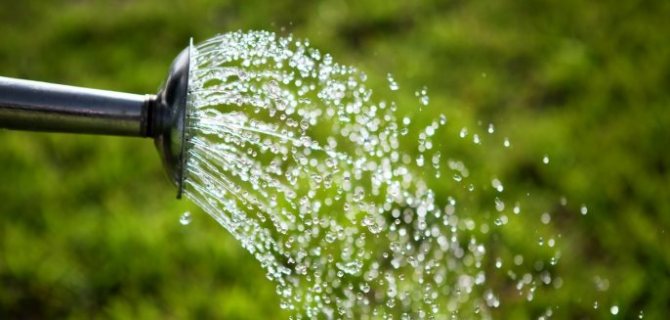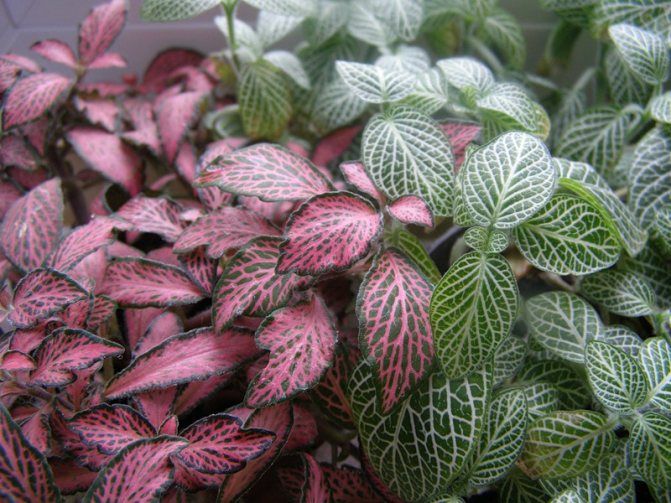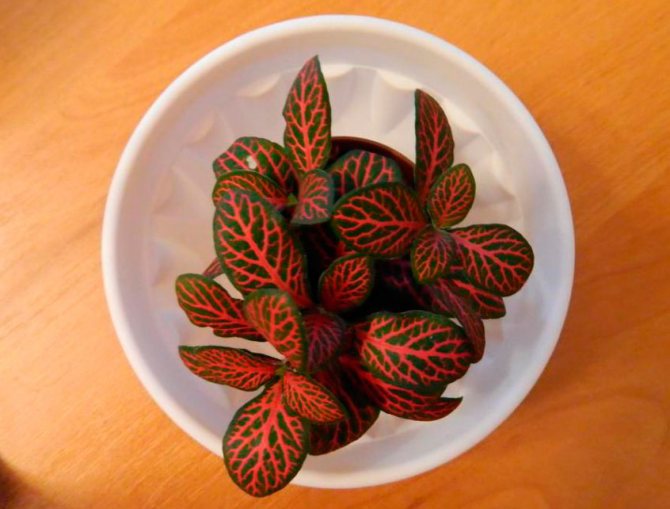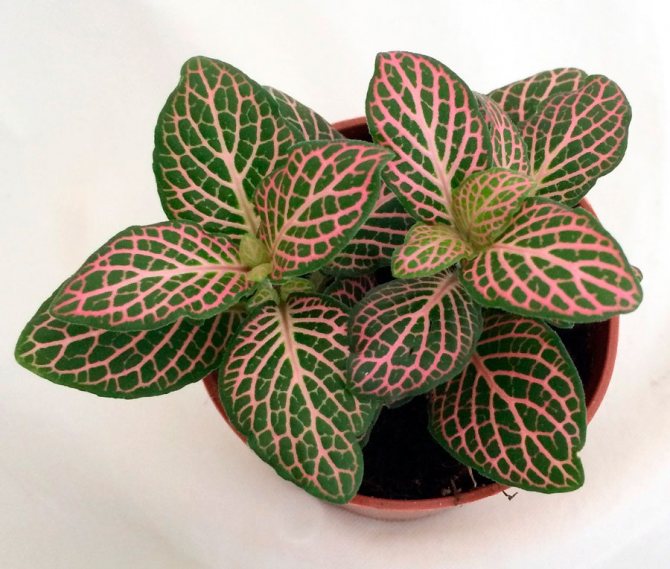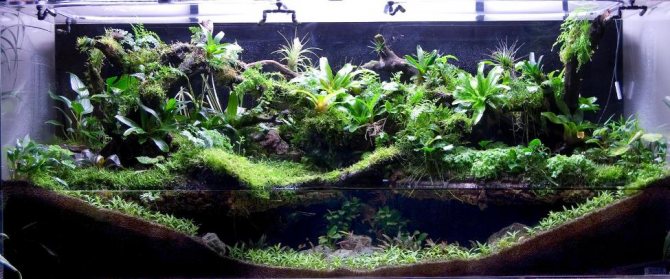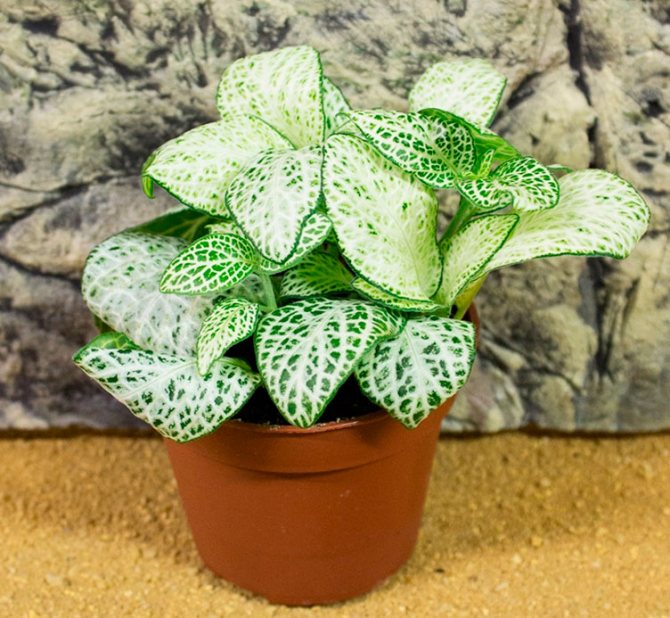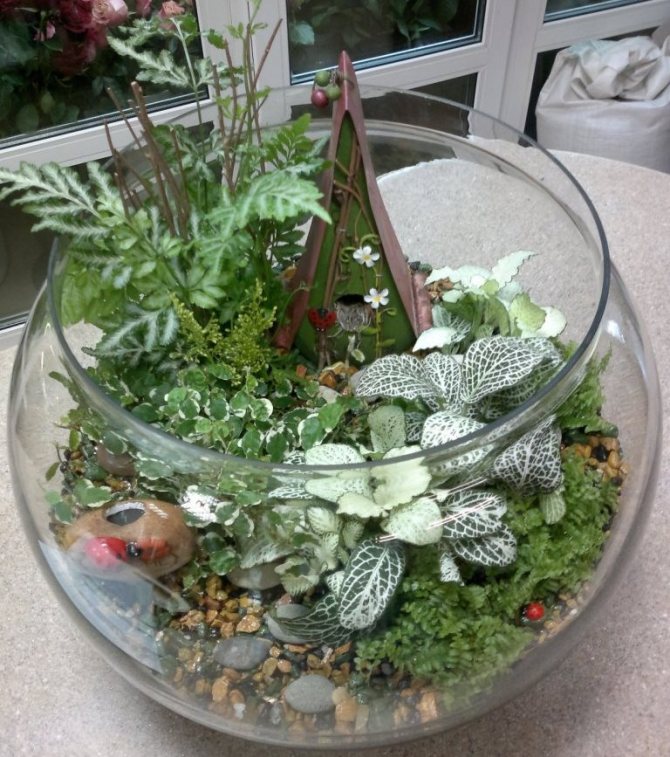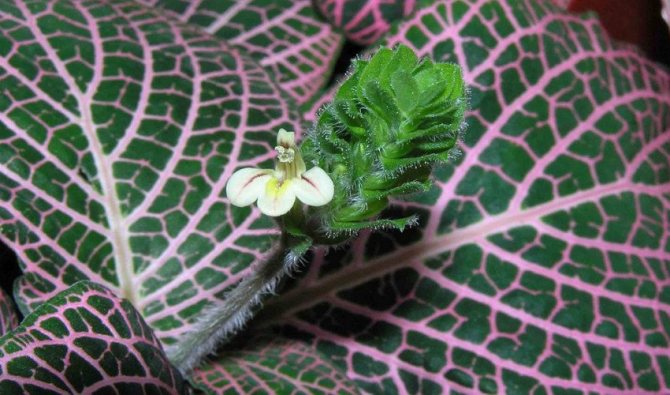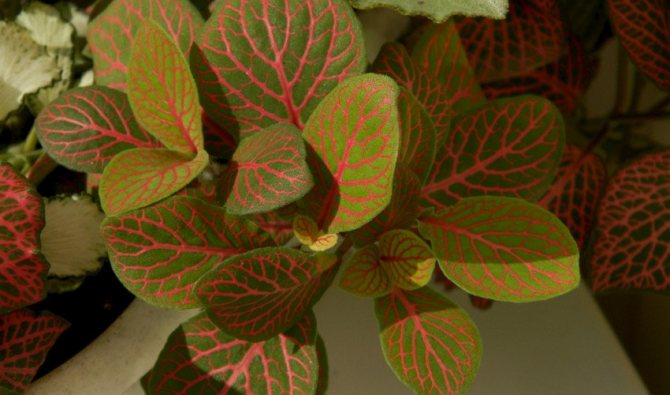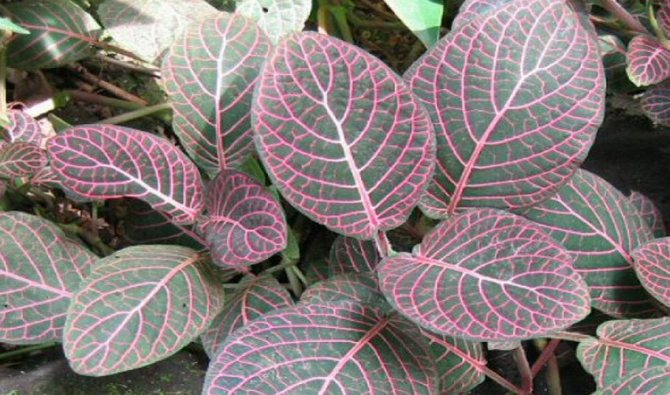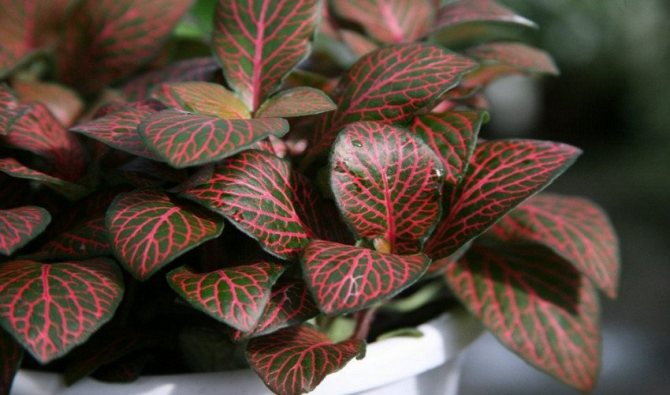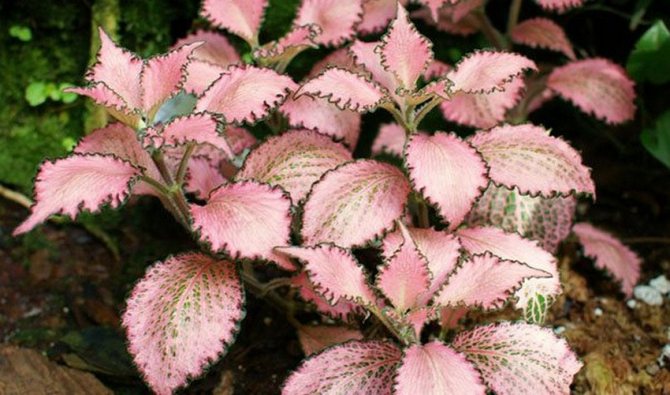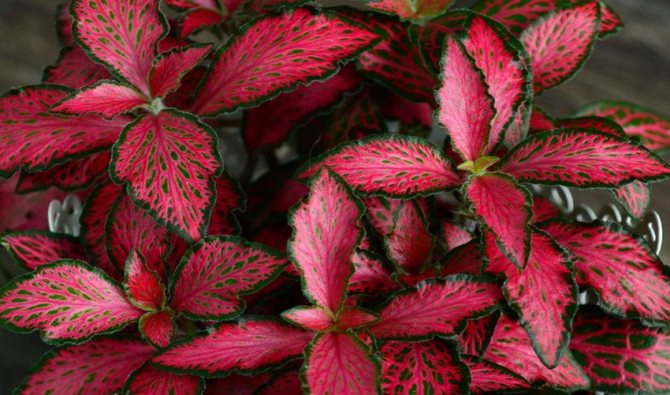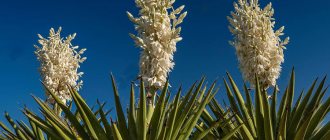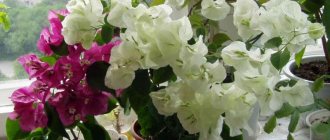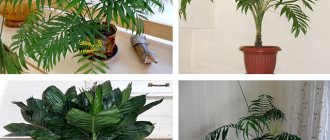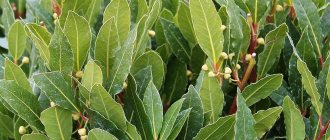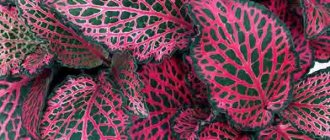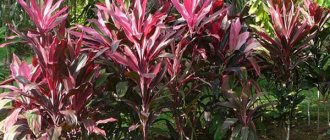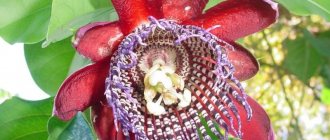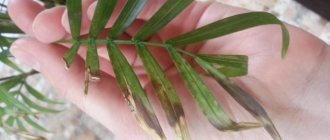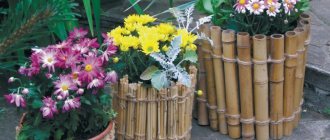The indoor plant Fittonia is not a simple character, and if you think that you will plant it in a beautiful pot, and it will grow by itself, without any participation on your part, then you are mistaken. We will have to study the nature and preferences of this tropical beauty, and create conditions at home similar to those to which she is accustomed to in her natural habitat. Wild species of Fittonia are generally not able to survive at home. Once this sissy was grown exclusively in greenhouses - only there it was possible to create the humid tropical conditions that she loves so much. But, at present, breeders have bred varieties that are not so picky about high humidity and temperature of content, and even novice growers can take care of Fittonia at home. And what a riot of colors can be observed in the hybrid varieties of this flower! In natural conditions, it looks much more modest.
What does fittonia look like, flower varieties
Mix fittonia bushes of small height, its stems beautifully spread over the soil. The length of the leaf can be from 2 to 16 cm. The leaves are colored green, sometimes with a purple tint. Veins are clearly visible on the plates.
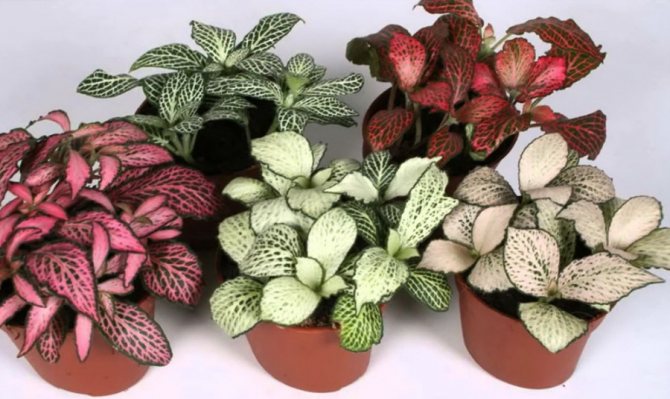
Home cultivation of fittonia of different types
Common varieties
The most common variety of Fittonia Mix is Belozhilkovaya. Other popular plant varieties:
- Vershaffelt - the shoots of the plant curl, they are covered with fluff. Over time, their silvery color changes to olive. The leaves of this variety are decorated with red veins.
- Silver - a relatively new hybrid, the length of the leaf is only 2.5 cm. At this size of the plate, the white pattern seems even more attractive.
- White Anna - the distinctive feature of the variety is a white pattern on the foliage, along the edges of which there is a dark edging.
Picture 2 Grade White Anna
Types and varieties of fittonia with photos and names
Fittonia Verschaffelt or white-tailed fittonia verschaffeltii = Fittonia albivenis
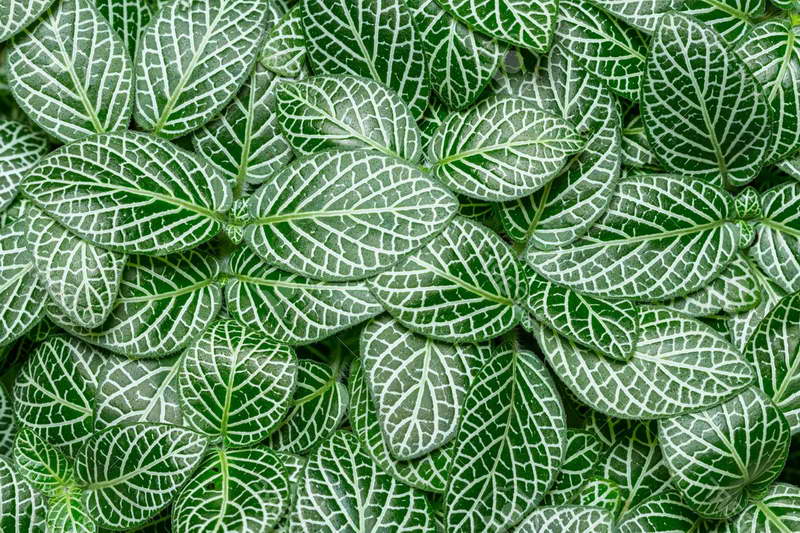

Fittonia Verschaffelt or white-necked fittonia verschaffeltii = Fittonia albivenis photo
A low-growing herb about 25 cm high. The shoots are creeping, the stems branch well. Large leaves have a dark green color with a pattern of veins of white, red, pink.
Varieties:
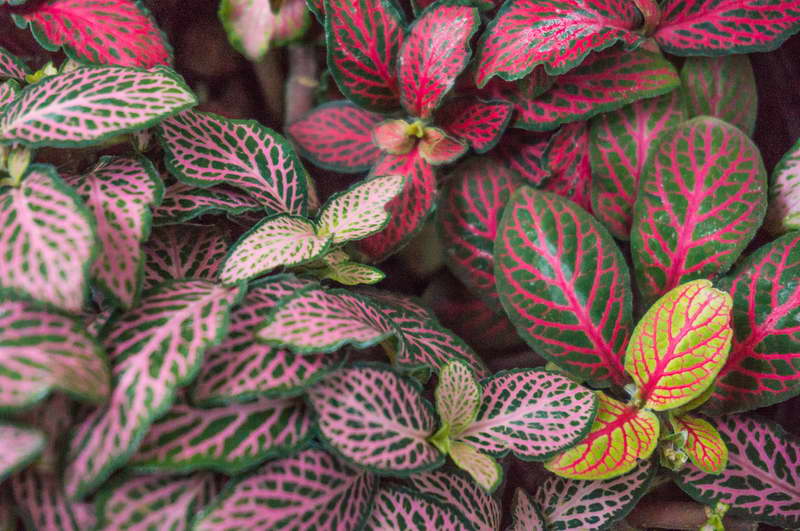

Fittonia Vershaffelt red and pink photo
- Fittonia silvery - leaf plates are smaller, veins of a white-silvery shade.
- Fittonia red - the color of the veins is red, lilac, pink, the center or edges may be more pronounced.
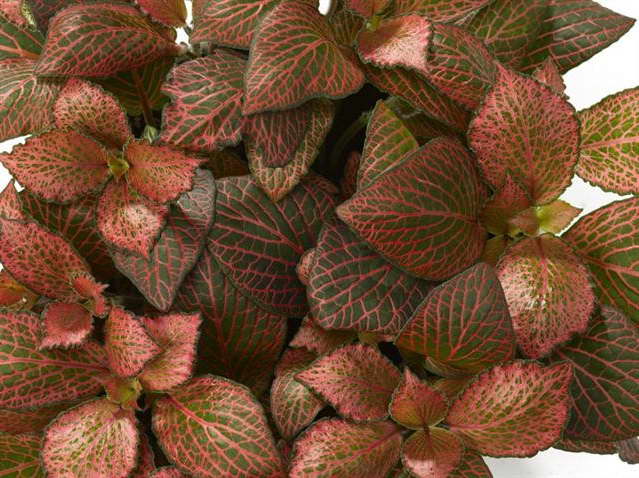

Fittonia Josan Photos
- Josan - the edges of the leaf plate are wavy, the main color is dark green, the veins have a coral hue.
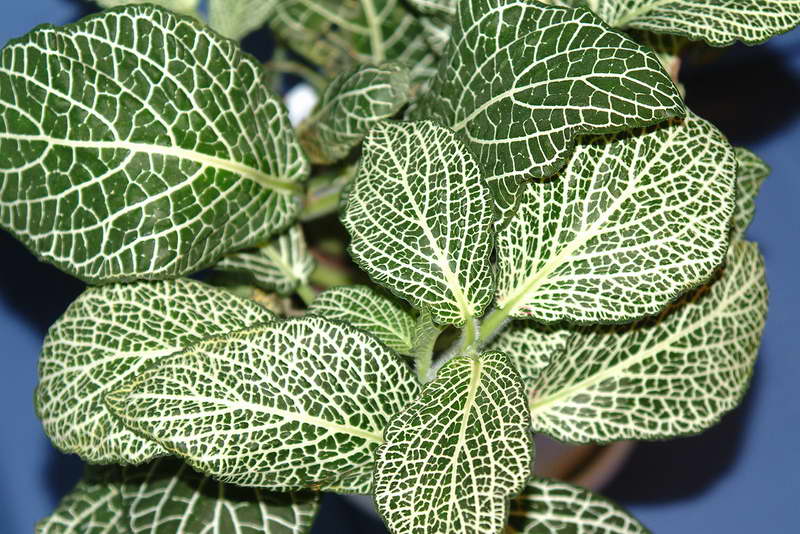

Fittonia white-necked White Anna White Anna photo
- White Anna - dark green leaves are bordered by a darker stripe, the pattern has a white-silver color.
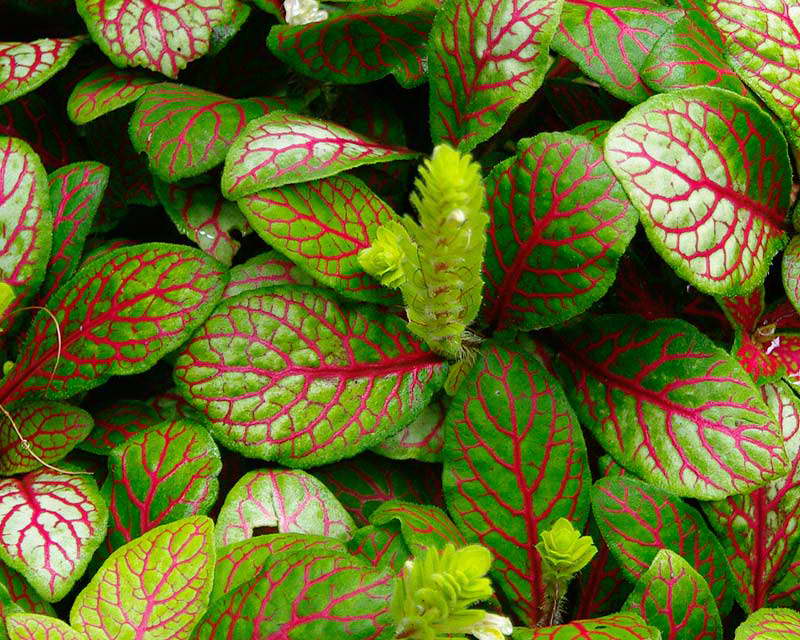

Fittonia albivenis Skeleton photo
- Fittonia Skeleton - the name is derived from the structure and color of the leaf plate. The leaves are small, matte, velvety. A dense network of red-burgundy veins adorns the leaf surface. The main color is olive.
Fittonia giant or large Fittonia gigantea
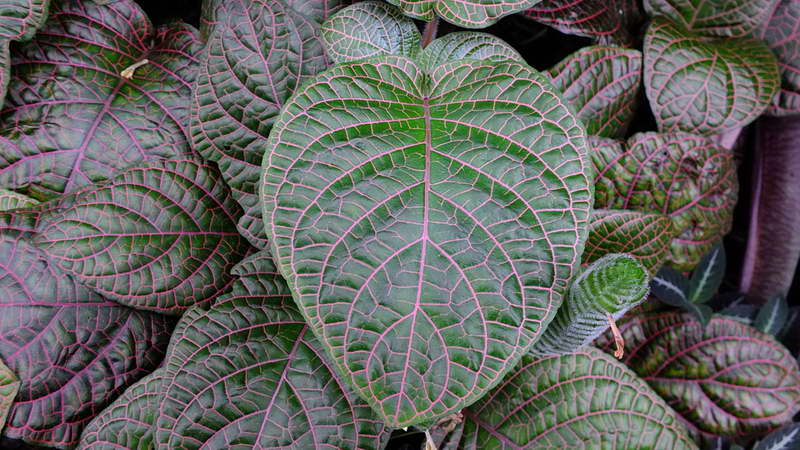

Fittonia giant or large Fittonia gigantea photo
The only species with erect shoots. They are pubescent. The plant reaches a height of about 60 cm.Leaves 10-16 cm long and 4-10 cm wide are attached on short petioles. The leaf plate is glossy, painted in dark green with a pattern of dark pink veins.
How to care for Fittonia at home
Subject to the cultivation technique, you can get a highly decorative plant.
Temperature
Fittonia - home care and reproduction
In summer, Fittonia prefers a temperature of +24 degrees, and in winter, +20 is enough for it. Lower temperatures in winter will lead to plant disease. Due to the presence of drafts or sudden changes in temperature, foliage can fly around the Fittonia.
Important! In spring or summer, placing a flower on a balcony or even in a garden is strongly discouraged.
Lighting
Indoor growing of Fittonia requires a lot of bright light. South windows will not work for the plant, but if there are no other options, the pot should be placed deep into the room to protect the foliage from direct sunlight. West and east windows will work best. On the north side, the flower will not die, but a lack of light will lead to a decrease in the decorativeness of its foliage. When daylight hours are shortened, it is important to use fluorescent lights to illuminate the fittonia.
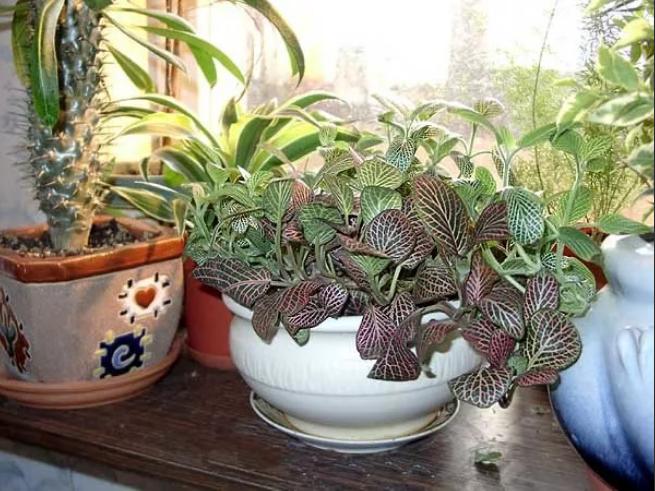

Fittonia on the window
Watering
When watering fittonia, you need to ensure that the earthy clod does not dry out, otherwise the plant will remain without foliage. Stagnation of water in a pot is also harmful, because it causes rotting of the root system. In summer, watering is carried out as soon as the ground is dry on top, and in winter - 2-3 days after the top layer of the soil dries up. Humidification is carried out only with settled warm water.
Spraying
Systematic spraying of foliage for this plant is simply necessary, otherwise the plates will begin to dry, fade and lose their decorative effect. Spraying is carried out once a day, and, if possible, in the morning and in the evening.
Important! Do not polish the leaves, this will harm Fittonia.
Humidity
Low air humidity leads to various diseases of Fittonia, in addition, pests may appear. To increase the humidity, you can put a tray with water and pebbles poured into it, and place a pot with a flower on top.
Priming
The soil for fittonia should be loose, well-permeable, but nutritious. A soil mixture of peat, sand, turf and coniferous soil is perfect.
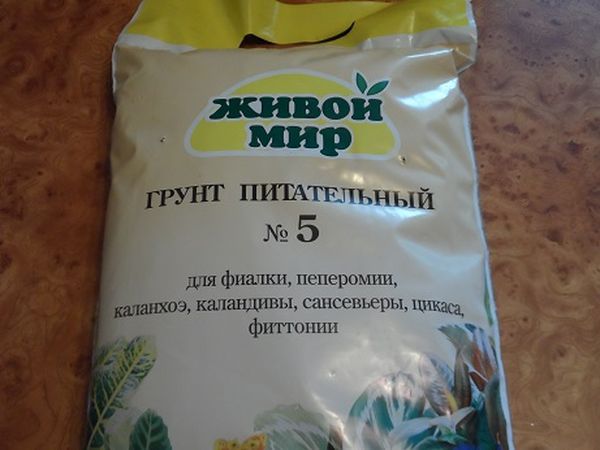

Soil for fittonia
Top dressing
The culture requires year-round feeding. But too much nutrient content will negatively affect the development of the plant. The manufacturer's packaging usually indicates the required dosage, but it is better to take half of the indicated volume. Complex mineral fertilizers are ideal.
Important! In winter, feeding will be required once a month, and in the warm season - once every 2 weeks.
Brief description of cultivation
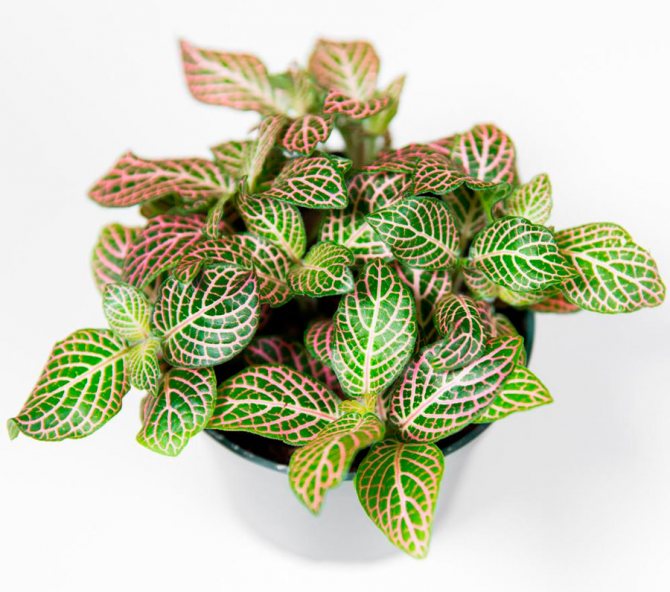

- Bloom... Fittonia is cultivated as an ornamental deciduous plant.
- Illumination... Needs a lot of bright light, but it must be diffused.
- Temperature regime... In summer it is about 24 degrees, and in winter it is about 20 degrees.
- Watering... Such a flower is watered systematically and in moderation. In spring and summer, this is done immediately after the top layer of the substrate in the pot dries out. In the cold season, it is recommended to do this after the soil mixture dries out to ¼ of the depth.
- Air humidity... Should be elevated. The bush must be systematically moistened with a sprayer in the morning and evening. In order to keep the air humidity high, wet pebbles can be poured into the pan, and an open vessel filled with water can also be placed next to the flower.
- Fertilizer... In the spring-autumn period, feeding is carried out 1 time in 15 days, for this, mineral fertilizers are used for ornamental deciduous plants, while the dosage should be reduced by half of that recommended by the manufacturer. In winter, the number of dressings is reduced to one in 30 days.
- Pruning... During the growing season, pinching of the tops of the stems is carried out. And in the last days of March, pruning of bare stems is carried out, and this is done in several stages.
- Dormant period... It is not pronounced.
- Transfer... The bushes are transplanted regularly once a year in the spring (March – April) immediately after they are pruned.
- Soil mixture... Sand, peat, coniferous and soddy soil (1: 1: 2: 2).
- Reproduction... By dividing the bush, layering and cuttings.
- Harmful insects... Thrips, scale insects, mealybugs and spider mites.
- Diseases... The culture loses its decorative appearance due to improper care or because the plant is already old.
Pruning
Hedera helix mix or common ivy - home care
To make the branching of the plant beautiful, and the bush itself turned out to be lush, you need to pinch the tops of the stems. This procedure should be done regularly. In the process of growth, the lower part of the fittonia is exposed, in this case the plant loses its decorative effect. Rejuvenation can be achieved by pruning at the end of March. Cutting off all the foliage at a time is not recommended, as the growth of young shoots will be extremely slow. Pruning is best done in several steps.
Fittonia: reproduction
Dieffenbachia flower - home care
It is recommended to propagate the flower every year at the time of transplantation, if necessary. Possible breeding methods:
- cuttings;
- dividing the bush;
- the use of air layers.
Rooting cuttings
From the top of the bush, you need to cut off part of the stem, on which several leaves remain. For rooting to take place quickly, the stalk should be no longer than 8 cm. The cut off part of the flower is placed in the sand. Cover the top with a jar. The roots will appear in a month.
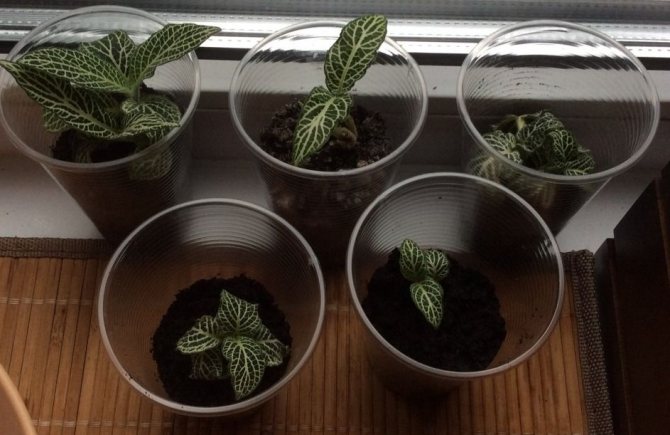

Flower propagation by cuttings
Air layering
The plant reproduces by layering on its own, but if you do not want to wait, then you can help the flower. A shoot without foliage must be pressed to the soil and dug a little. After a while, roots will appear in this place. The shoot is cut and planted in a separate container.
Dividing the bush
When transplanting, the bush is divided into several parts, and then the resulting plants are planted in different pots. The procedure is carried out carefully so as not to injure the delicate roots of the plant.
Diseases
Trouble can arise with improper care of Fittonia.
Let's take a look at what happens to a plant and why it happens to it.
- insufficient watering, low humidity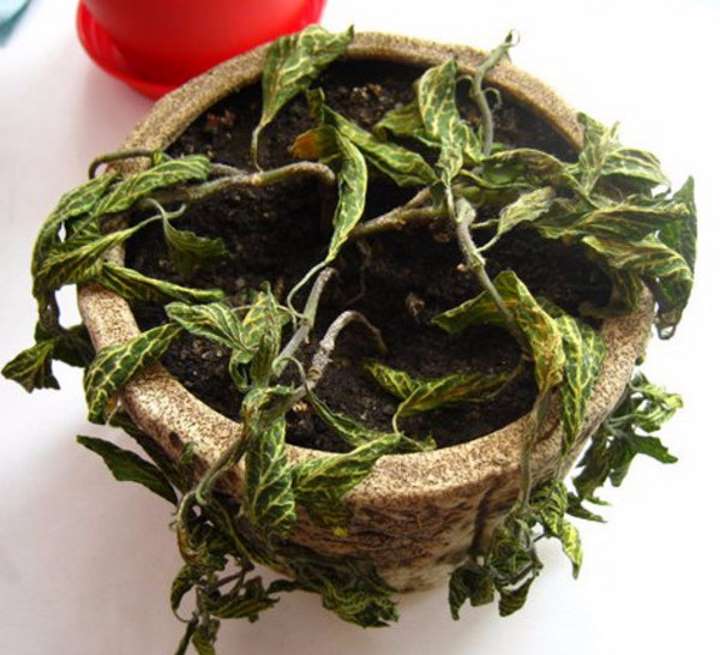

Curled leaves- Leaves turn yellow - dry air, watering weak, spider mite.
- Stalks rot - low temperature
- Falling leaves- poor lighting, low temperature and drought.
- Spots on the leaves - sunburn, excess moisture, bacteria or fungi.
- Weak color, the sheet has become thin - insufficient light or minerals.
With a great desire and love for the fittonia flower, you can grow it into a noble representative of decorative deciduous plants at home.
Transfer
The bush grows quite quickly, so at a young age it needs to be replanted annually. As the fittonia grows, transplants are carried out less often - 1 procedure in 3 years will be enough. Fittonia mix in a pot should feel spacious. The transplant is carried out by the transshipment method without cleaning the root system from soil.
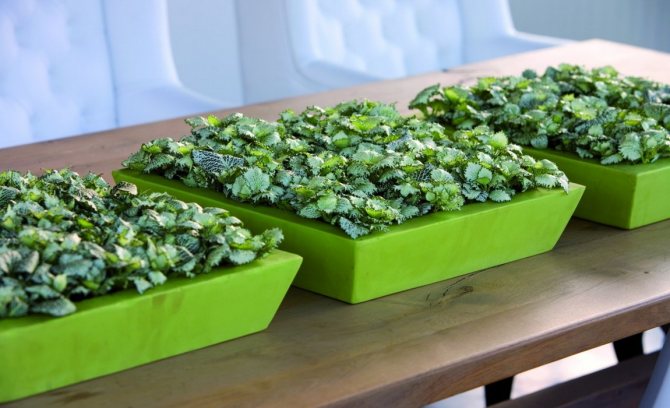

Planting fittonia mix in wide containers
Where and how it grows
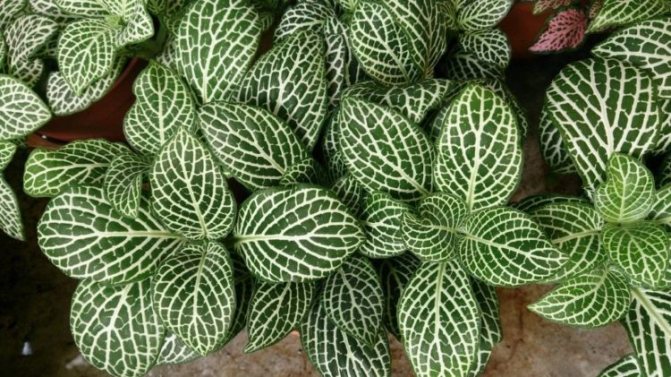

A very attractive flower, Fittonia is a perennial plant and consists of branched stems that spread along the ground. This plant has a height of up to 10 cm, a superficial fibrous root system.On contact with the ground, the fleecy stems take root. Petiole oval-shaped leaves are located close to each other, smooth, with blunt edges. On the reverse side, the leaves are fleecy, their length is 6-10 cm. Olive-green leaves along the veins have thin shiny stripes. On young leaves, these stripes are silvery, yellow, or pink, and as they mature, they turn greenish.
In spring or summer, a long peduncle grows from the leaves of the plant, which gives small buds resembling a spikelet, the flowers themselves bloom alternately from bottom to top. In terms of aesthetics, they are of little value. Their diameter is up to 1 cm.
The plant is undersized, so it can be easily grown indoors. But there are exceptions: fittonia can be creeping or gigantic. Popular ampel and pochopokrovny cultivation of this culture.
Possible growing problems and diseases
Despite the high resistance of Fittonia to diseases and pests, problems may arise if agrotechnical rules are not followed.
The flower sheds buds and leaves
This is how Fittonia reports that it lacks light and moisture. The plant may not be getting enough micronutrients. It is necessary to rearrange the pot to a more lighted place and revise the watering schedule.
Leaves turn pale
This sign appears when moisture stagnates in the soil. The volume and number of irrigations should be reduced.
The tips of the leaves dry
This is due to a lack of nutrients or oversaturation of the soil with fertilizers. It is worth revising the feeding scheme.
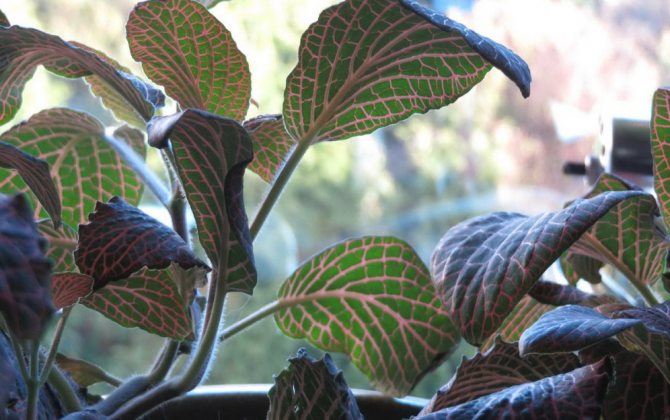

Dried fittonia leaves
The lower leaves fall
This process is natural, you do not need to do anything. As it grows, the stem becomes bare, but you can rejuvenate the flower to increase its decorative effect.
Pests
Fittonia is often attacked by insects:
- aphid;
- shield;
- thrips;
- spider mites;
- mealybugs.
To combat pests, a soap solution is used, and in more advanced cases, chemicals cannot be dispensed with.
Reviews about growing Fittonia
I have been familiar with this plant for a long time. It grows compactly, always in excellent condition and pleases with its variegated coloring no less than flowering plants, which, as soon as they bloom, lose their appearance until the next flowering. This baby feels great in very well-humid rooms, requires frequent spraying and watering, but it is not necessary to overmoisten too much so that the roots do not rot, but it should not dry out either, as its beautiful leaves can dry out or fall off. Therefore, you should not keep it on southern windowsills and near heating. You can put Fittonia in dark places, for example, among ferns or other moisture-loving plants that love light and can slightly shade Fittonia with their large leaves. Direct sunlight burns it, but at the same time, in the dark, the shoots will stretch out strongly and can lose the brightness and contrast of the coloring. Alas, my last Fittonia died from pests. She cannot resist the scabbard and the mite, so it was not possible to save her. Always process new plants that you buy or take from somewhere, send them to quarantine.
LvIcO4ka
In some magazine I read that Fittonia is called an elegant houseplant, and I completely agree with them, there is no other word for it. These leaves with pink veins look so unusual and interesting!
Gabriella S
Fittonia attracted me with beautiful leaves - red with green veins. But the relationship with her did not work out! I grew up in the summer, everything was fine, I sprayed it every day. But with the onset of cold weather, it began to wither. There were five plants in the pot, they grew into a beautiful bush. Now there is only one branch left, the type of plant has become completely different! I read that it can be planted in a pot to any plant, so that the fittonia creates a beautiful view of the composition as a whole.In the spring I will buy Fittonia again. The red flowers or leaves of plants are said to increase the vitality of households. I don't have enough energy! Well, I'll wait for spring!
mardan
Signs and superstitions
All signs associated with Fittonia are positive. The plant helps to improve the atmosphere in the home and smooth out any conflicts that arise. With it, you can reduce the number of fights in the house and increase the frequency of visiting guests. Fittonia promotes friendship and love. The negative energy in the house is completely absorbed.
Fittonia mix and caring for it at home will not cause much trouble even for a novice florist. To get an ornamental and healthy plant, you need to carry out elementary agrotechnical work in a timely manner.
Popular varieties
At first, growers grew this plant in greenhouses, since at home it was impossible to create the humid conditions that a tropical flower requires.
To date, specially bred varieties, the flowers of which are not so whimsical to humidity and temperature, which makes it easy to grow at home.
There are 4 species in the genus. Red Fittonia with an intense bloody pattern on the leaves looks unusual and exotic. The most popular varieties for home breeding are Vershaffelt, Skeleton and Mix.
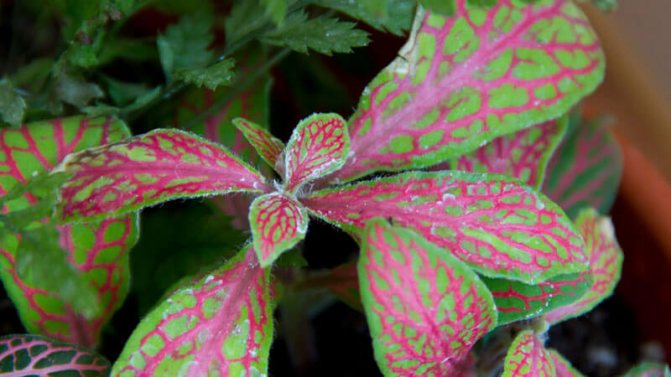

Vershaffelt
This flower is distinguished by creeping shoots and branching stems. Fittonia Vershaffelt has large, dark green leaves veined in various shades. This type of flower reaches 25 cm in height, loves high humidity and warmth. Well suited for flower arrangements.
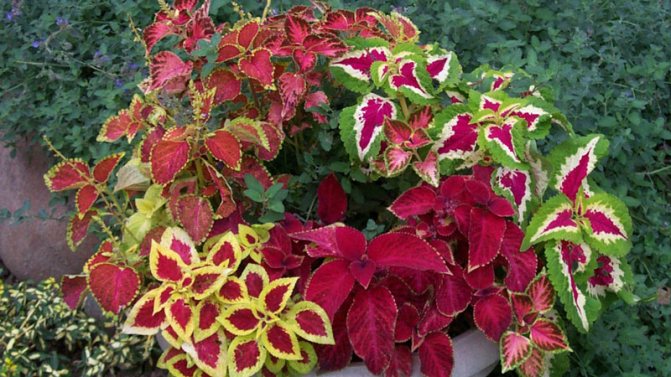

Skeleton
A very beautiful plant with creeping shoots. It has small velvety leaves with a matte shade and red, densely applied veins. The leaves have a rich olive color, due to the intensity of the color they create a luminous effect.
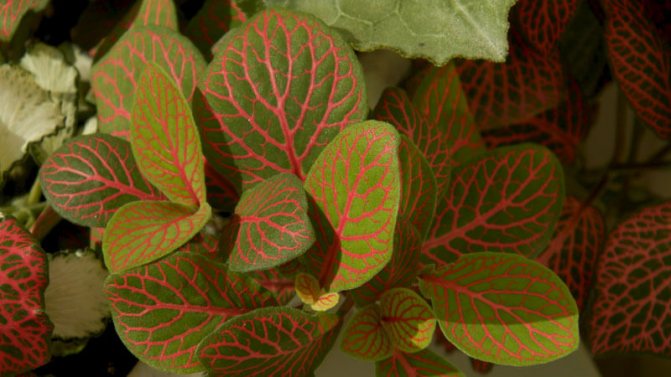

Mix
It is a collection of several varieties planted together. Florists select different varieties, plant them in one pot, choosing a range of colors so that the plant fits into the interior design.
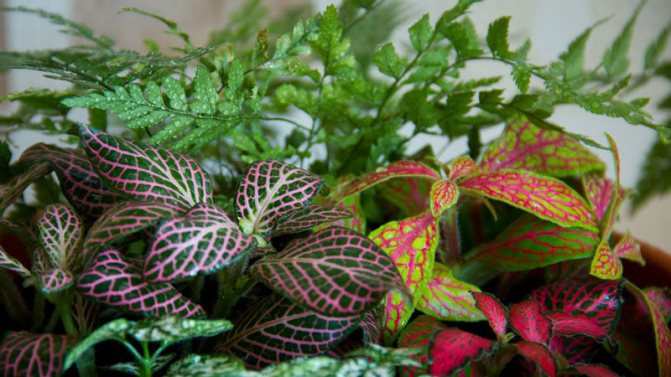

The colors of the leaves vary from light green to dark green, and are decorated with veins of various shades. Due to the variety of shades, this flower looks organically on any windowsill.

